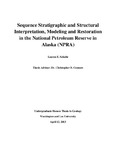Sequence Stratigraphic and Structural Interpretation, Modeling and Restoration in the National Petroleum Reserve in Alaska (NPRA) (thesis)

View/
Author
Schultz, Lauren Elizabeth
Subject
Washington and Lee University -- Honors in Geology
Alaska -- National Petroleum Reserve
Sequence stratigraphy
Geological modeling
Alaska -- Brooks Range
Metadata
Show full item recordDescription
Thesis; [FULL-TEXT FREELY AVAILABLE ONLINE] Lauren Elizabeth Schultz is a member of the Class of 2013 of Washington and Lee University. This thesis examines Mesozoic progradational clinoform sequences, as well as deformation associated with the Brooks Range orogeny in the National Petroleum Reserve in Alaska (NPRA). Brookian, Beaufortian and upper Ellesmerian stratigraphic horizons were interpreted in a sequence stratigraphic framework along several thousand kilometers of 2D seismic lines in NPRA, and thrusting and resulting folding were interpreted in the foothills of the Brooks Range. An internally consistent 3D model of the region with detailed attention to both structural and sequence stratigraphic inputs was generated using seismic and well log constraints, extending from the Brooks Range foothills to approximately the Arctic coastline. The model makes use of previous interpretations of several depositional sequences in the Shublik Formation and Kingak Shale. Additionally, this model contributes refinement of stratigraphic interpretations of the significant clinoform sequences in the Torok and Nanushuk. In particular, more than ten distinct sequence packages that can be tied across 5000 line kilometers of regional seismic lines were interpreted. Structural interpretations of the faulting and deformation in the foothills of the Brooks Range were also developed, incorporating principles of fault-related folding.
We recognize progradation of the Torok shelf margin consistent with previous work, and contribute a more detailed interpretation across the NPRA with the additional clinoform sequences. Our model maps the Kingak relict shelf margin geometry prior to deformation, which controlled accommodation for subsequent deposition of the Torok and Nanushuk formations. Progradation of the Torok and Nanushuk sequences to the northeast has a significant impact on stratigraphic interpretation in the region, as sequence layer thickness can have considerable variation through space, independent of structural deformation.
This sequence stratigraphic architecture also aids interpretation of deformed regions. For example, the positions of certain stratigraphic intervals appear to control structural deformation to a large extent. Detachments form along sequence boundaries associated with the Carbon Creek fault system, thickening in the northern foothills occurs in slope facies in the Torok, and the stratigraphic position of local detachment horizons appears to be associated with sequence boundaries, with upper detachments localized in the slope facies of the Torok Formation. We recognize buried thrusts in the northern foothills that require transport of multiple km of slip to the paleo-surface. Lauren E. Schultz